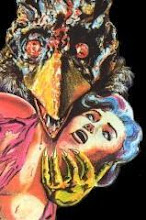 As I said in one of my more recent posts, I'm trying to squeeze out as much reading time as possible as my final days of summer slowly pass me by. And if I read anything that I deem cool and/or awesome, then I'm obligated to write about it here for posterity's sake. So without further ado, here ya go:
As I said in one of my more recent posts, I'm trying to squeeze out as much reading time as possible as my final days of summer slowly pass me by. And if I read anything that I deem cool and/or awesome, then I'm obligated to write about it here for posterity's sake. So without further ado, here ya go:
Masters of Doom:
Masters of Doom (published in 2003) is about the creative partnership of John Carmack and John Romero, the duo that would play a major role in creating such computer game landmarks as Wolfenstein 3D, Doom, and Quake. While the book is a work of journalism, it is written like a novel with lots of dialogue, scenes, and lots of emphasis placed on characters. Stylistically it almost resembles a geeky version of Ron Suskind's A Hope in the Unseen. This emphasis on character is what makes the book so compelling and readable. I was never a big PC gamer myself and hadn't played the majority of the games mentioned in the book, but thanks to Masters of Doom's compelling character descriptions and brisk pacing, my disinterest in PC gaming was irrelevant to my enjoyment of the story.
The story of Masters of Doom is a typical American rags to riches fable with a modern tech geek twist. Both Johns emerge from their traumatic teen years ready to take the young computer game industry by storm. They pay their dues working up the ranks and eventually start their own game company. Their success accentuates their personality differences. Carmack's an introverted and brilliant programmer, whereas Romero is an extroverted video game celeb. These personalities eventually drive their friendship apart and push each in different personal directions. As I said, it's a classic American myth that trots out all of our culture's favorite cliches and archetypes (the kids who came from nothing and made something of themselves, the loneliness of fame, the eccentric young creatives, etc.) Far from making the story dull, these familiar plot points lend the story a timeless, mythic quality. Despite being published almost ten years ago, this book felt fresh and relevant to me as I read it.
Masters of Doom is also valuable for its behind the scenes info on the electronic gaming industry. I might of never been a big PC gamer, but I was all about video games back in the day, and thus I enjoyed reading about the behind the scenes workings of the industry. It's also pretty cool to read something that sheds light on the personalities creating the games. Compared to pop singers, Hollywood directors, or even bestselling authors, most game designers are relatively obscure. Thus it's interesting to read something that illuminates who makes these games and explores what makes them tick. You'll also absorb a mass of video game history as you read. While Masters of Doom is not a video game history book, gaming history provides the background to the main story and it is inevitable that the reader will pick up some trivia as he or she progresses through the story.
For gamers and geeks, Masters of Doom is a supremely entertaining read. If the subject matter speaks to you I recommend you pick it up.









